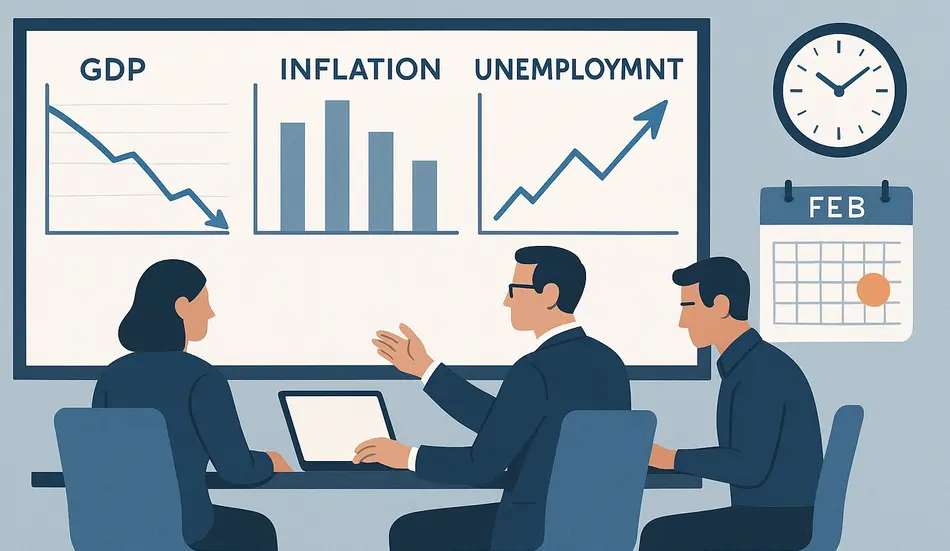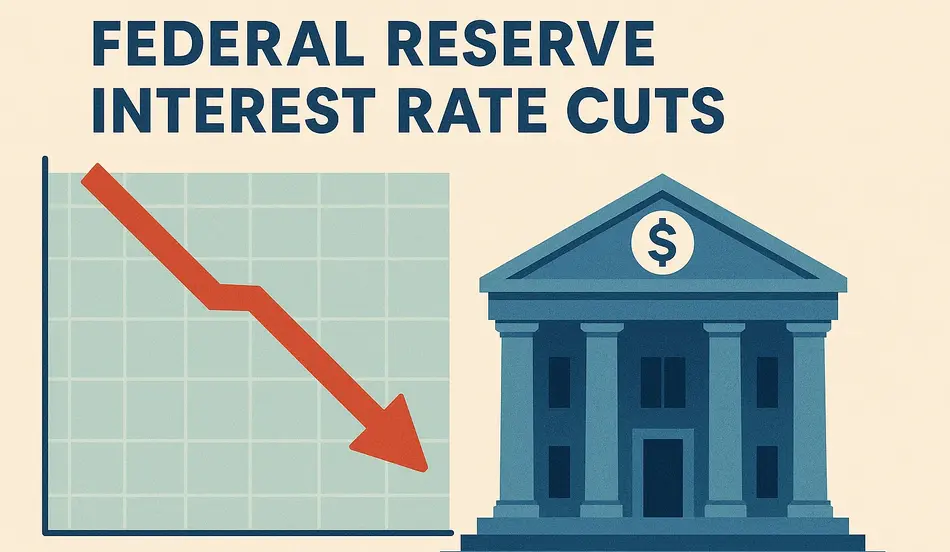Markets Increasingly Expect Earlier Fed Rate Cuts as Economic Indicators Soften
Financial markets are rapidly adjusting their expectations for Federal Reserve interest rate cuts in 2025, with growing sentiment that the central bank may act sooner and more aggressively than previously anticipated. While earlier projections called for approximately 0.5% in rate reductions during the second half of the year—with 0.25% cuts in September and December—market pricing now suggests nearly a 50% probability of a third cut before year-end. This shift comes as economic indicators point to softening conditions despite reasonably strong recent employment figures.
Key Economic Indicators Driving Fed Rate Cut Expectations
Employment Data: Critical Period Ahead
This week’s jobs report will be closely monitored as a pivotal indicator for Federal Reserve interest rate cuts. While expectations suggest around 100,000 jobs were added maintaining relative stability in the labor market several leading indicators point to potential weakness ahead:
- Business employment surveys showing declining hiring intentions
- Decreasing job vacancy numbers across multiple sectors
- Rising jobless claims suggesting labor market cooling
- July through September identified as a critical assessment period
These employment metrics carry particular significance as the Federal Reserve operates under a dual mandate: targeting 2% inflation while maximizing employment. Should labor market conditions deteriorate more rapidly than anticipated, pressure for earlier Federal Reserve interest rate cuts would intensify significantly.
Explore current job opportunities across various sectors on WhatJobs
Fed Officials Signal Potential Rate Cut Timing
The internal debate among Federal Reserve officials regarding interest rate cuts is becoming increasingly visible. Two officials—Kevin Walsh and Michelle Bowman—have suggested they could potentially vote for a rate cut as early as July, representing a notably hawkish shift. However, most committee members maintain a more conservative stance, preferring to ensure that:
- Inflation continues its downward trajectory toward the 2% target
- Any price impacts from tariffs represent only short-term phenomena
- Employment data shows clear signs of requiring monetary support
This cautious approach aligns with the Federal Reserve’s historical preference for data-dependent decision-making, though market participants increasingly believe economic conditions will force earlier action on interest rate cuts than officials currently acknowledge.
Trade Tensions and Their Impact on Rate Cut Decisions
Tariff Deadlines and Market Implications
Trade discussions will continue making headlines as deadlines approach for potential import taxes. The fourth of July holiday-shortened week will see particular focus on trade developments that could influence Federal Reserve interest rate cuts. Key considerations include:
- Potential economic impact if new tariffs are implemented
- Whether trade tensions escalate or deescalate in coming weeks
- How supply chain disruptions might affect inflation metrics
- Market reaction to trade policy announcements
The Federal Reserve must carefully balance these factors, as trade-related inflation could complicate the case for interest rate cuts even if employment data weakens. However, most officials appear to view potential tariff impacts as transitory rather than structural inflation drivers.

Learn how economic trends affect job markets on WhatJobs
European Economic Indicators: Contrasting with U.S. Outlook
Eurozone Inflation and Unemployment Trends
While U.S. markets focus on Federal Reserve interest rate cuts, European economic indicators present an interesting contrast. The European Central Bank has already lowered rates to 2%, responding to very benign inflation readings in recent months. For June, however, analysts note:
- Higher oil prices translating to slight increases at the pump
- Disproportionately weak services inflation data from May suggesting potential rebound
- Expectations for inflation to continue hovering around 2% amid sluggish economic activity
The Eurozone labor market shows a fascinating regional divergence that differs from U.S. patterns. Despite weakness in northern Eurozone employment markets, southern nations are experiencing improving conditions:
- Spain, Italy, Greece, and Portugal showing declining unemployment rates
- Record low overall Eurozone unemployment despite regional variations
- Expectations for continued strong labor demand in southern regions
- Unemployment rates projected to remain in the low 6% range
This north-south labor market divergence creates a complex picture for ECB policymakers, though their recent rate cut suggests they view inflation risks as more pressing than employment concerns.
📢 Hiring? Post Jobs During Federal Reserve Rate Cuts
As Federal Reserve interest rate cuts approach and economic conditions shift, securing top-tier candidates becomes critical to business resilience.
WhatJobs connects you with skilled, motivated professionals looking for stability and growth in today’s evolving job market.
👉 Post a Job TodayHow Federal Reserve Interest Rate Cuts Could Impact Different Sectors
Consumer Spending and Retail
When the Federal Reserve implements interest rate cuts, consumer borrowing costs typically decrease, potentially stimulating spending in several key areas:
- Automotive sales often see immediate benefits as financing costs decrease
- Housing markets generally respond positively to lower mortgage rates
- Retail discretionary spending may increase as consumer confidence improves
- Credit card interest rates eventually adjust downward, easing household debt burdens
These effects don’t manifest immediately after Federal Reserve interest rate cuts are announced, but rather develop gradually as rate changes work through the financial system. Businesses in consumer-facing industries should monitor these trends closely to anticipate demand shifts.
Employment Markets and Wage Growth
Federal Reserve interest rate cuts typically aim to stimulate economic activity during periods of slowing growth. This monetary policy shift can affect employment markets in several ways:
- Short-term stabilization: Rate cuts may prevent more aggressive layoffs in struggling sectors
- Hiring hesitation: Companies might remain cautious about expanding workforces despite lower borrowing costs
- Wage pressure moderation: Slowing economic conditions often reduce upward pressure on wages
- Sector divergence: Some industries benefit more quickly from rate cuts than others
For job seekers, understanding which sectors historically respond most positively to Federal Reserve interest rate cuts can help inform career decisions during economic transitions.
Find opportunities in growing sectors on WhatJobs
Investment Markets and Retirement Planning
Interest rate decisions by the Federal Reserve have significant implications for investment strategies and retirement planning:
- Bond values typically increase when rates are cut, benefiting existing bondholders
- Equity markets often rally on rate cut announcements, though economic fundamentals matter more long-term
- Real estate investments may see valuation increases as mortgage rates decline
- Cash holdings and savings accounts yield less, potentially pushing investors toward riskier assets
These dynamics create both opportunities and challenges for individuals planning for retirement or managing investment portfolios during periods of Federal Reserve interest rate cuts.
FAQ: Federal Reserve Interest Rate Cuts
When is the Federal Reserve expected to cut interest rates?
Financial markets are increasingly pricing in Federal Reserve interest rate cuts earlier than previously expected. While initial projections called for 0.25% cuts in September and December, market sentiment now suggests a nearly 50% probability of a third cut before year-end. Some Fed officials, including Kevin Walsh and Michelle Bowman, have even suggested they could potentially vote for a rate cut as early as July, though most committee members maintain a more conservative stance.
How do employment numbers affect Federal Reserve interest rate decisions?
Employment data significantly influences Federal Reserve interest rate decisions due to the Fed’s dual mandate of price stability and maximum employment. While recent jobs reports have shown reasonable stability with around 100,000 jobs added, leading indicators such as business employment surveys, decreasing job vacancies, and rising jobless claims suggest potential weakness ahead. July through September is identified as a critical assessment period that could determine the timing of Federal Reserve interest rate cuts.
What economic indicators suggest earlier Federal Reserve interest rate cuts?
Several economic indicators point to potentially earlier Federal Reserve interest rate cuts: softening business employment surveys, decreasing job vacancy numbers, rising jobless claims, and trade tensions that could impact economic growth. Additionally, inflation has been trending closer to the Fed’s 2% target, giving the central bank more flexibility to focus on its employment mandate. Market participants are closely watching these indicators for signs that could accelerate the timeline for interest rate reductions.
How do Eurozone economic conditions compare to U.S. conditions regarding interest rates?
The European Central Bank has already lowered rates to 2%, responding to benign inflation readings in recent months. Unlike the U.S., the Eurozone shows interesting regional labor market divergence, with northern regions experiencing weakness while southern nations like Spain, Italy, Greece, and Portugal show improving employment conditions. Overall Eurozone unemployment remains at record lows despite regional variations, with rates projected to stay in the low 6% range. This contrasts with U.S. conditions, where Federal Reserve interest rate cuts are still being debated amid mixed economic signals.
Understand how interest rates affect job markets on WhatJobs
Preparing for Federal Reserve Interest Rate Cuts: Strategic Considerations
As Federal Reserve interest rate cuts become increasingly likely, individuals and businesses should consider several strategic adjustments. For businesses, this may be an opportune time to secure longer-term financing before potential economic weakness emerges. For individuals, reviewing mortgage refinancing options and adjusting investment portfolios to account for changing interest rate environments could prove beneficial.
The coming weeks will be critical in determining whether Federal Reserve interest rate cuts arrive sooner than initially expected. Thursday’s economic data releases will be particularly significant, potentially cementing market expectations for more aggressive monetary policy easing if employment indicators continue to soften.
By staying informed about these economic developments and understanding their potential impact, both businesses and individuals can position themselves advantageously for the changing financial landscape that Federal Reserve interest rate cuts will create.
Conclusion: Navigating the Changing Economic Landscape
The increasing likelihood of Federal Reserve interest rate cuts represents a significant shift in the economic outlook. While earlier projections suggested modest rate reductions later in the year, current indicators point to potentially earlier and more aggressive action. This evolving monetary policy landscape will create both challenges and opportunities across various sectors of the economy.
For businesses, consumers, and investors alike, staying informed about these developments is crucial for effective decision-making. By understanding the potential impacts of Federal Reserve interest rate cuts on employment, consumer spending, and investment markets, stakeholders can better position themselves for the changing economic environment ahead.
As we monitor upcoming economic data releases and Federal Reserve communications, one thing remains clear: adaptability will be key to navigating the economic transitions that Federal Reserve interest rate cuts will inevitably bring.
Explore job opportunities across various economic sectors on WhatJobs




